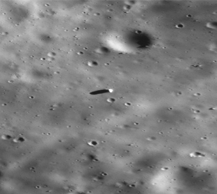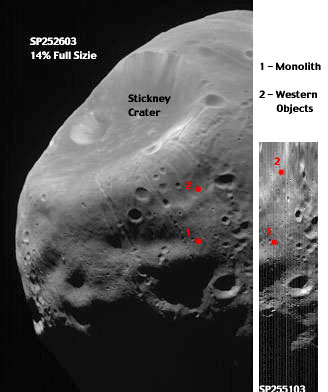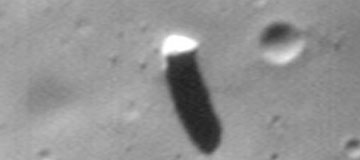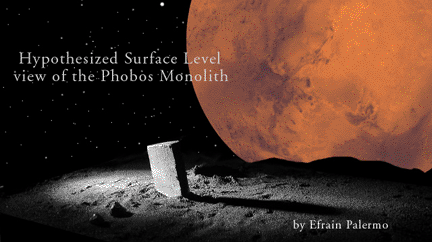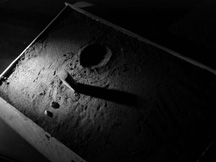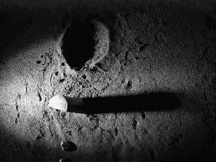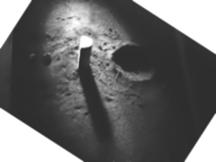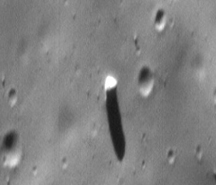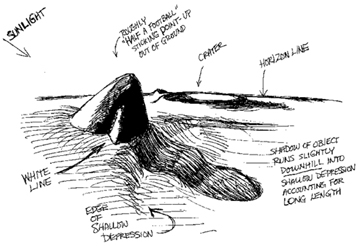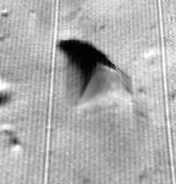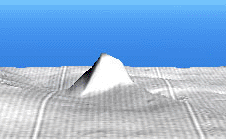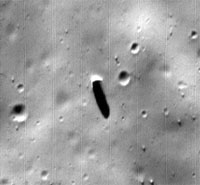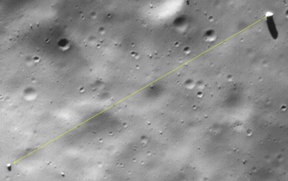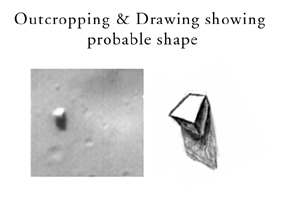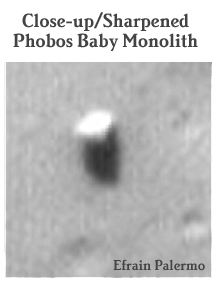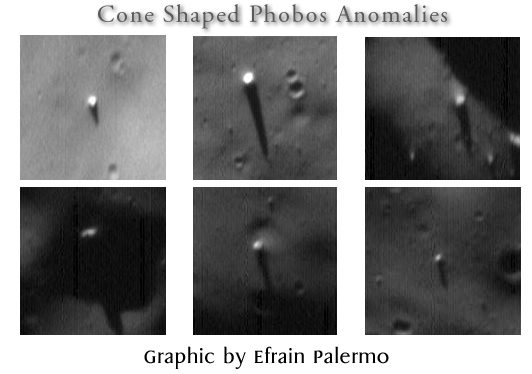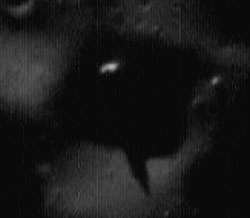|
|
|
2005 from PalermoProject Website
While studying the above Phobos image (a
composite of
sp255103 frames A through O) my eye
caught something sticking up out of the surface (inside blue
square), it was difficult to make out at the browser size so I
downloaded it into Photoshop and zoomed into that area, and there it
was, an apparent cylindrical shaped object casting a longish shadow
and having a slanted roof.
I searched the net to see if anyone else had already seen this and to see what they thought about it, but my searches came up empty on this Phobos mystery.
One of my searches however led me to Dr.
Mark Carlotto who had done ground breaking imaging work on
the Cydonia region.
He referred me to Lan Fleming a NASA imaging specialist who has interest in Mars and other solar system anomalies.
Lan looked at it and upon further examination and study concluded as did I, that this was a physical anomaly on the surface of Phobos.
The original NASA MOC image was distorted slightly
due to how the camera
operates, so the craters appeared 'oval'
making it round which
adjusted the entire image at the same time.
It is very easy to be tricked by light and shadows, as an artist one learns to manipulate a flat, 2D reality into a 3D illusion.
As an artist and sculptor I like to see
and feel in 3D. I felt that if I could recreate the Monolith in 3D
and apply the same angle and lighting conditions, that I could bring
out the intrinsic form and shape in question.
I set the light (sun) at an approx. angle close to the sun angle in the MOC image. (See images below).
Compare the diorama to the MOC image. It's close, enough to speculate that this is an artifact sticking up out of the surface.
Image drawn by Andy
Romano
My interpretation of this structure on Phobos is that it is a building shaped artifact casting a long shadow from a relatively high sun angle, if it was a low sun angle, then any medium sized protrusion would cast a long shadow that's not proportionate to it's height.
Lan Fleming did an extensive study of the sun and shadows on the web site pages he devoted to this Phobos Monolith.
There have been other interpretations,
most notably that it is an angular shaped rock placed in such a way
that it casts a long shadow. In the image above drawn by Andy Romano
and sent to me in November 2000, he theorized a pyramid shaped rock
whose shadow dipped into a depression and thereby elongating it's
shadow.
Mac Tonnies in his Cydonia Imperative, also pointed out that this could not be a remnant of the Stickney Crater impact as such a large mass would have escaped Phobos feeble gravity.
There is no weather on Phobos so this
could not be caused by erosion factors.
The Phobos monolith (in the upper right corner of the image above) has a pointed roof (or pyramid corner) which points towards another anomalous object I call the 'Baby Monolith'.
It's a block shaped object which appears to have a squarish roof top and whose shadow indicates it rises above the ground.
The resolution of the images is 1.80
meters per pixel. The baby Monolith is about 30 feet high by 30 wide
and 54 feet long. I haven't the foggiest idea what the relationship
is between the two objects. It could be a geologic coincidence or
some other esoteric purpose.
The image in the upper left hand corner in the panel of images above shows a particularly pointed object. What's curious is that there is no weathering/erosion process to create this feature.
The image on the lower leftmost panel shows what I call the 'Crater Statue" (blowup above).
|



